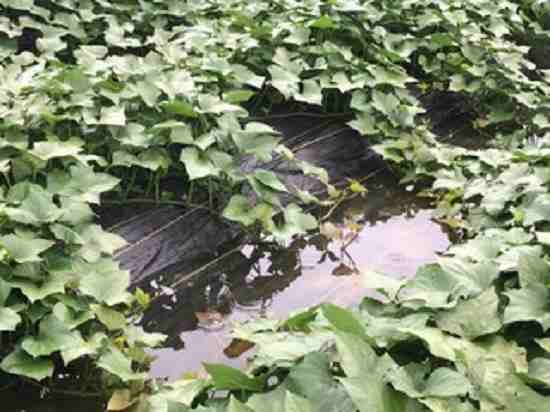
Among all the resilient growing practices at House in the Woods Farm, it is the raised beds that really saved the day in 2018, the rainiest season on Maryland record. Our county of Frederick had flash flooding in May due to as much as six inches of rain falling within three hours. And it continued to rain steadily all year. It rained more days than not, even during the summer when we are used to dry weather.
With seven inch raised beds, the rain collected in rivers between the elevated crops instead of drowning the plants. Raised beds help with drainage and keep crops up on rows like islands above the rivers of water that settle in on the rainiest days. The rivers of rain have time to seep into the paths between beds. Even temporary flooding can devastate a crop or drown a set of new seedlings. The raised plants are held up high on islands of dry ground while the rivers have time to drain, illustrated by this photo of our sweet potato plants.
Another resilient technique that helps with drainage is the quality of the soil. Our soil is rich and loamy, so it drains well. Our farm sits on an ideal soil region, but we have also made it better by adding nutrients and plant materials back into the soil. Over the past two decades of growing, we have built up the organic matter in the soil, enriching the soil and improving the drainage.
The crops may be protected by our raised beds and rich soil, but I have to admit our spirits got a little soggy. Planting seedlings on raised beds while you trudge through mucky paths just takes more out of you. Harvesting in the rain and changing your clothes four times in one day is tiring. Soggy conditions. Mostly, the rains of 2018 dampened our spirits. I am looking forward to this season for a renewal of energy on the farm. Every year is a new year, and the spring crops are starting strong.
Despite 2018’s record rains, I am grateful for our relatively bountiful harvests last year. We matched our sweet potato and tomato harvests from years past. We grow tomatoes under the protection of hoophouses, so their skins do not split in rainy weather. Surely those hoops saved our tomatoes. We grow a wide variety of crops for our Community Supported Agriculture (CSA) members. Growing diverse crops helps the farm in extreme conditions, when some crops thrive better than others. Some of the spring cabbages suffered from the rainy conditions. Our spring and fall harvests were less diverse than usual, but we had a decent variety for CSA customers, full of peppers, eggplants, tomatoes, garlic, potatoes, sweet potatoes and more. As farmers reported losses and more losses, flooded fields and rotted crops, I am grateful to our resilient growing practices, such as raised beds and hoophouses and building rich soil. These are the techniques that helped us thrive in a year of extreme rain conditions.
How do we make raised beds at House in the Woods Farm? Using our farm innovation called the Mulchinator, which adapts a plastic mulch layer to lay and reroll reusable black cloth. For information about House in the Woods Farm’s Mulchinator, see this blog and this video.
written by Ilene White Freedman for Mother Earth News 4/29/2019
